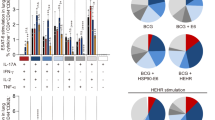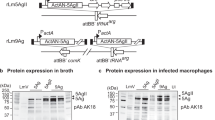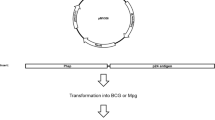Abstract
Tuberculosis is the most widespread and lethal infectious disease affecting humans. Immunization of mice with plasmid DNA constructs encoding one of the secreted components of Mycobacterium tuberculosis, antigen 85 (Ag85), induced substantial humoral and cell–mediated immune responses and conferred significant protection against challenge with live M. tuberculosis and M. bovis bacille Calmette–Guérin (BCG). These results indicate that immunization with DNA encoding a mycobacterial antigen provides an efficient and simple method for generating protective immunity and that this technique may be useful for defining the protective antigens of M. tuberculosis, leading to the development of a more effective vaccine.
This is a preview of subscription content, access via your institution
Access options
Subscribe to this journal
Receive 12 print issues and online access
$209.00 per year
only $17.42 per issue
Buy this article
- Purchase on Springer Link
- Instant access to full article PDF
Prices may be subject to local taxes which are calculated during checkout
Similar content being viewed by others
References
Donnelly, J.J., Ulmer, J.B. & Liu, M.A. Immunization with DNA. J. Immunol. Methods 176, 145–152 (1994).
Ulmer, J.B. et al. Heterologous protection against influenza by injection of DNA encoding a viral protein. Science 259, 1745–1749 (1993).
Andersen, P. Effective vaccination of mice against Mycobacterium tuberculosis infection with a soluble mixture of secreted mycobacterial proteins. Infect. Immun. 62, 2536–2544 (1994).
Wiker, H.G. & Harboe, M. The antigen 85 complex: A major secretion product of Mycobacterium tuberculosis . Microbiol. Rev. 56, 648–661 (1992).
Launois, P. et al. T cell epitope mapping of the major secreted mycobacterial antigen Ag85A in tuberculosis and leprosy. Infect. Immun. 62, 3679–3687 (1994).
Launois, P. et al. The major secreted antigen complex (Ag85) from M. bovis bacille Calmette-Guérin is associated with protective T cells in leprosy: A follow-up study of 45 household contacts. J. Infect. Dis. 167, 1160–1167 (1993).
Kaufmann, S.H.E. Immunity to intracellular bacteria. Annu. Rev. Immunol. 11, 129–190 (1993).
Haanen, J.B.A.G. et al. Selection of a human T helper type-1 like T cell subset by mycobacteria. J. Exp. Med. 174, 583–592 (1991).
Yamamura, M. et al. Defining protective responses to pathogens: Cytokine profiles in leprosy lesions. Science 254, 277–279 (1991).
Huygen, K. et al. Spleen cell cytokine secretion in Mycobacterium bovis BCG infected mice. Infect. Immun. 60 2880–2886 (1992).
Nathan, C.F., Murray, H.W., Wiebe, M.E. & Rubin, B.Y. Identification of interferon-γ as the lymphokine that activates human macrophage oxidative metabolism and antimicrobial activity. J. Exp. Med. 158, 670–689 (1983).
Dalton, D.K. et al. Multiple defects of immune cell function in mice disrupted interferon-γ genes. Science 259 1739–1742 (1993).
Flynn, J.L. et al. Role for interferon-gamma in resistance to Mycobacterium tuberculosis infection. J. Exp. Med. 178, 2249–2254 (1993).
Cooper, A.M. et al. Disseminated tuberculosis in interferon-gamma gene disrupted mice. J. Exp. Med. 178, 2243–2247 (1993).
Flynn, J.L. et al. Tumor necrosis factor-α is required in the protective immune response against Mycobacterium tuberculosis in mice. Immunity 2 561–572 (1995).
Appelberg, R. & Orme, I.M. Effector mechanisms involved in cytokine-mediated bacteriostasis of Mycobacterium avium infections in murine macrophages. Immunology 80, 352–359 (1993).
Denis, M. & Ghadirian, E. Granulocyte-macrophage colony-stimulating factor restricts growth of tubercle bacilli in human macrophages. Immunol. Lett. 24, 203–206 (1990).
Flynn, J.L., Goldstein, M.A., Treibold, K.J., Roller, B. & Bloom, B.R. Major histocompatibility complex class I-restricted T cells are required for resistance to Mycobacterium tuberculosis . Proc. Natl. Acad. Sci. USA 89, 12013–12017 (1992).
Silva, C.L. et al. Protection against tuberculosis by bone marrow cells expressing mycobacterial hsp65. Immunology 86, 519–524 (1995).
Horwitz, M.A., Lee, B-W.E., Dillon, B.J. & Harth, G. Protective immunity against tuberculosis induced by vaccination with major extracellular proteins of Mycobacterium tuberculosis . Proc. Natl. Acad. Sci. USA 92, 1530–1534 (1995).
Griffin, J.P. & Orme, I.M. Evolution of CD4 T-cell subsets following infection of naive and memory immune mice with Mycobacterium tuberculosis . Infect. Immun. 62, 1683–1690 (1994).
Barry, M.A., Lai, W.C. & Johnston, S.A. Protection against mycoplasma infection using expression-library immunization. Nature 377, 632–634 (1995).
Borremans, M.L. et al. Cloning, sequence determination and expression of a 32-kDa protein gene from M. tuberculosis . Infect. Immun. 57, 3122–3130 (1989).
Shiver, J.W., Perry, H.C., Davies, M.E. & Liu, M.A. Immune responses to HIV gp120 elicited by DNA vaccination. in Vaccines 95 (eds. Chanock, R.M. Brown, F. Ginsberg, H.S. & Norrby, E.) 95–98 (Cold Spring Harbor Laboratory Press, Cold Spring Harbor, New York, 1995).
Montgomery, D.L. et al. Heterologous and homologous protection against influenza A by DNA vaccination: Optimization of DNA vectors. DNA Cell Biol. 12, 777–783 (1993).
Huygen, K. et al. Mapping of TH1 helper T cell epitopes on major secreted mycobacterial antigen 85A in mice infected with live Mycobacterium bovis BCG. Infect. Immun. 62, 363–370 (1994).
Huygen, K. et al. Influence of genes from the major histocompatibility complex on the antibody repertoire against culture filtrate antigens in mice infected with live Mycobacterium bovis BCG. Infect. Immun. 61, 2687–2693 (1993).
De Bruyn, J. et al. Purification, characterization and identification of a 32 kDa protein antigen of Mycobacterium bovis BCG. Microbial Pathogen. 2, 351–366 (1987).
Denis, O., Latinne, D., Nisol, F. & Bazin, H. Resting B cells can act as antigen presenting cells in vivo and induce antibody responses. Int. Immunol. 5, 71–78 (1993).
Parish, C.R. & Müllbacher, A. Automated colorimetric assay for T cell cytotoxicity. J. Immunol. Meth. 58, 225–237 (1983).
Author information
Authors and Affiliations
Rights and permissions
About this article
Cite this article
Huygen, K., Content, J., Denis, O. et al. Immunogenicity and protective efficacy of a tuberculosis DNA vaccine. Nat Med 2, 893–898 (1996). https://doi.org/10.1038/nm0896-893
Received:
Accepted:
Issue Date:
DOI: https://doi.org/10.1038/nm0896-893
This article is cited by
-
Key advances in vaccine development for tuberculosis—success and challenges
npj Vaccines (2023)
-
A multiple T cell epitope comprising DNA vaccine boosts the protective efficacy of Bacillus Calmette–Guérin (BCG) against Mycobacterium tuberculosis
BMC Infectious Diseases (2020)
-
Mycobacterium Tuberculosis and Interactions with the Host Immune System: Opportunities for Nanoparticle Based Immunotherapeutics and Vaccines
Pharmaceutical Research (2019)
-
A Comparative Approach to Strategies for Cloning, Expression, and Purification of Mycobacterium tuberculosis Mycolyl Transferase 85B and Evaluation of Immune Responses in BALB/c Mice
Molecular Biotechnology (2014)
-
Adjunctive immunotherapy with α-crystallin based DNA vaccination reduces Tuberculosis chemotherapy period in chronically infected mice
Scientific Reports (2013)



